Duncan’s Scientific Method Excludes Widom-Larsen Theory
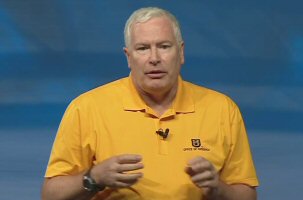 Dec. 3, 2012 – By Steven B. Krivit –
Dec. 3, 2012 – By Steven B. Krivit –
(Updated 7:53 pm) –
Last summer, National Instruments invited Robert Duncan, vice chancellor for research at the University of Missouri, to speak at its annual trade show. Duncan spoke about following the scientific method without prejudice to see where the data lead, in order to solve the mysteries of low-energy nuclear reactions. (A partial transcript follows below.)
In 2009, Duncan’s hypothesis for LENRs was based on the idea, proposed by former Brigham Young University professor Steven E. Jones, of muon-catalyzed deuterium-deuterium fusion. Now, Duncan says that nobody has any understanding of the mechanism behind LENRs. At the National Instruments trade show, he presented a list of theories, taken from the New Energy Times Web site, although he failed to credit us as the source. He said that the LENR field has no viable theory supported by current physics.
Duncan omitted from his slide the Widom-Larsen theory, which is based on current physics. The Widom-Larsen theory does not propose any form of fusion but is based on weak interactions and neutron-capture processes. It is the only LENR theory to be recognized by CERN, the European Centre for Nuclear Research, or by NASA or by the Defense Threat Reduction Agency. The theory has been published in the mainstream peer-reviewed journals Pramana and the European Physical Journal C – Particles and Fields and several other mainstream publications. It is the only theory to have obtained such broad recognition.
In January 2012, the University of Missouri accepted a $5.5 million gift from Sidney Kimmel, based on Duncan’s assertion that LENRs lack a viable explanation and that Kimmel’s funds would be applied to “try to figure this puzzle out,” according to Duncan. The gift establishes the Sidney Kimmel Institute for Nuclear Renaissance at the University of Missouri and funds it for five years.
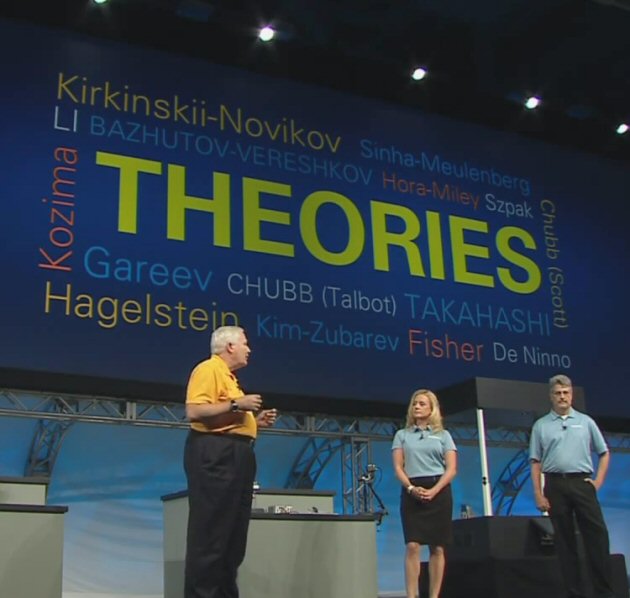
Duncan’s list of theories, based on the New Energy Times theory index.
[DAP errMsgTemplate=”” isLoggedIn=”N”]
Although a recognized theory for the LENR field helps the field’s credibility, the Widom-Larsen theory has not been welcomed by everyone. In the past few years, many LENR scientists who believe in “cold fusion” have attempted to discredit or ignore the Widom-Larsen theory. They have also attempted to ignore all nuclear products and emissions reported in the field, with the exception of helium-4, because these phenomena disprove the hypothesis of “cold fusion.” Part of the strategy of some of the “cold fusion” believers, with Duncan’s encouragement, has been an attempt to rebrand “cold fusion,” or LENR, as an “anomalous heat effect.” Just a few years ago, they attempted to rebrand LENR as the “Fleischmann-Pons Effect.”
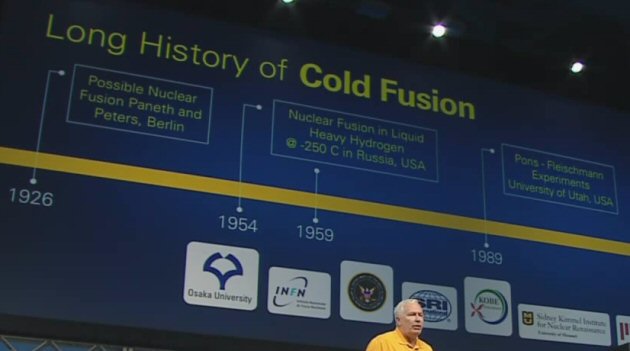
Duncan’s slide “Long History of Cold Fusion”
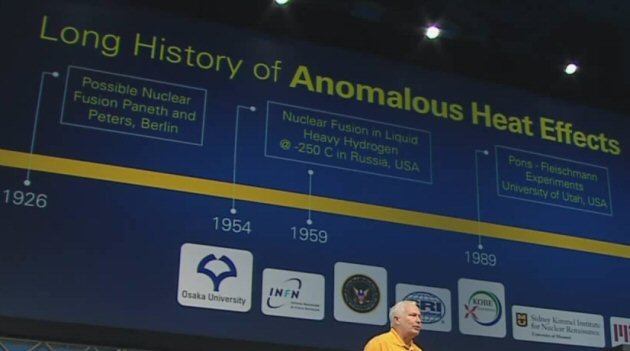
Duncan’s slide “Long History of Anomalous Heat Effects”
In his slide “Long History of Anomalous Heat Effects,” Duncan labels the 1926 Paneth and Peters work an anomalous heat effect. This is incorrect. Paneth and Peters did not attempt to measure heat. Their work was about nuclear transmutations, as indicated by the title of their paper, “On the Transmutation of Hydrogen into Helium.”
An additional correction to Duncan’s presentation is that Paneth and Peters did not say that they found an error. After several months of controversy following their initial publication, they wrote a follow-up paper and instead speculated about additional possible explanations for their measurement of helium. They had used two experimental methods, and in one, although they did not find a definitive error, they retracted their claim. In the other method, they were unable to speculate on how that helium measurement could have been the result of an artifact. They did not retract that claim.
Duncan’s reference to muon-catalyzed fusion as an anomalous heat effect is also incorrect. This experimental method does not produce excess heat. It does, however, produce very low fluxes of neutrons.
Duncan will chair the 18th International Conference on Cold Fusion next year at the University of Missouri. His co-chair is Yeong Kim, a theorist from Purdue University who has been proposing a “cold fusion” theory for 23 years.
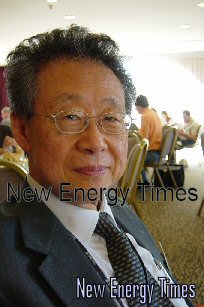
Yeong Kim. Photo: S.B. Krivit
In the past year, New Energy Times contacted Kim several times and asked for his help in understanding more about his theory. New Energy Times asked him, among other questions, whether he could provide a simple explanation of the mechanics of his theory, whether he could provide us with any informal articles that could be understood by a lay audience, whether he could show us any visual examples of data that directly correspond to his theory, and whether he could direct us to any independent third-party references that endorsed his theory. Kim did not respond.
In September, New Energy Times contacted Duncan by e-mail and asked him whether he still believed in “cold fusion.” The exchange follows:
New Energy Times: In your view, how likely is it that any kind of fusion process explains the anomalous heat and nuclear products seen in this field?
Rob Duncan: I think that there is very little experimental evidence to support the D+D –> 4He (24 MeV heat to lattice) cold fusion hypothesis. Even if there is a mechanism that can impart the energy of this reaction to the lattice to avoid particle radiation, as has been posited, then there are still many other remaining concerns. But Mike McKubre’s data on 4He production does appear to support the D+D hypothesis. So it is too early to rule the D+D hypothesis off the table, especially since Mike McKubre’s data seem quite compelling.
New Energy Times: Which of McKubre’s experimental data appears to support the D+D hypothesis? I am aware of only two possible sets of his work that relate to your statement: the Les Case replication performed in 1998 and first reported in 2000, and the EPRI-sponsored M-Series experiments performed in 1994 and reported to EPRI in 1998.
Duncan: I was referring to the data that Mike shows that suggest that one 4He atom is produced for every 30 MeV of excess heat. They attribute the difference from 24 MeV to helium retention in the metal. Please contact Mike for the proper references.
New Energy Times: The 30 MeV data you’re talking about is the 1998 Case replication reported in 2000. In this work, McKubre reported 31 MeV (Gradient Q) or 32 MeV (Differential Q).
Here is the reference: Michael McKubre, Francis Tanzella, Paolo Tripodi and Peter Hagelstein, “ The Emergence of a Coherent Explanation for Anomalies Observed in D/Pd and H/Pd Systems; Evidence for 4He and 3He Production ,” 8th International Conference on Cold Fusion. Lerici (La Spezia), Italy: Italian Physical Society, Bologna, Italy, (2000)
Note that there was no bulk metal in this experiment; nor was it performed in an electrolytic environment. This was a D2 gas experiment with a Pd-on-carbon catalyst.
I suppose there is a remote chance that some helium might have been retained in the Pd coating on the carbon, if helium was soluble in metals. Regardless, I direct your attention to a survey I performed on the topic of helium/hydrogen permeability and solubility in metals.
Duncan: I leave it to the authors to discuss their work in detail. I was just acknowledging its existence, and clearly you located the proper reference. Our initial data suggest that something unknown, other than fusion, is going on. We still have to do much more work before we can be definitive, but we will certainly publish once we can be definitive on this question.
Partial Transcript of Aug. 8, 2012, Presentation at National Instruments Trade Show
Shelly Gretlein, Director of Software Marketing
Greg Morrow, Principal Software Architect
Rob Duncan, Vice Chancellor for Research, University of Missouri
Rob Duncan: Three national labs from around the world and literally hundreds of other reports from scientists and professors have verified that this excess heat reported by [Martin] Fleischmann and [Stanley] Pons is in fact real, is in fact correct; so the situation is that we’re not sure what it is. Personally, I would prefer not to call it cold fusion – but rather call it what I know it is, which is an anomalous heat effect – until we really understand its origin.
Shelly Gretlein: So Dr. Duncan, with this anomalous heat effect, there are so many milestones, so many people working on this. Why is it so difficult to solve, 23 years later?
Duncan: That’s a great question. The situation is there are many different theories for what may be going on, and these theories many times are mutually exclusive. The path ahead of us now is to go back, as Galileo would, and apply the scientific method without prejudice, time and time again, until we get at which of these ideas is the one that stands up against experimental scrutiny.
Gretlein: Where would you say we are now in terms of next steps?
Duncan: I would say that, now that we understand that this anomalous heat effect is real, which is really a big surprise, and since we don’t understand it within current physics, we must conclude that our understanding of physics is somewhat incomplete. At the Sidney Kimmel Institute for Nuclear Renaissance, at the University of Missouri, we’re very committed to expanding the experimental range of inquiry, our experimental approach, following strictly the scientific method to the point where we’ll be able to again get at what the actual underlying mechanism is. We just want to dispassionately follow the scientific method, go where the data leads us, and that way we will understand what this actually is.
…
Gretlein: Dr. Duncan just explained anomalous heat effects. Can you tell us more about how your team got involved in the AHE?
Greg Morrow: “… [James Truchard and Lothar Wenzel] were getting excited about the anomalous heat experiments not just because of the potential for new science and technology or a novel energy source but also because the long-standing mystery seemed like a great opportunity to apply LabVIEW and accelerate the science. We could use LabVIEW to control and to instrument experiments, and certainly that was the case at several of the labs already, but we hit on another idea, which is that can we use the high-performance computing methodology to help accelerate the theoretical side of this equation.
Gretlein: So we have two ways we could go after looking at this. We can really tackle the theoretical side and apply the computational power, or look at the more experimental side. Can you tell us about the theory first?
Morrow: We have to remember that, in the intervening years, 26 years since Fleischmann and Pons, the computing landscape has evolved significantly, and LabVIEW has been there every step of the way. We hatched the collaboration with Professor Yeong Kim from Purdue University in Indiana, who’s been a long-standing theorist in this area. Under Dr. Kim’s guidance, we created a number of different simulations with LabVIEW to explore basic aspects of the theory. One of the common threads in several of the theories is the notion of lattice vibrations in solid palladium. We created this virtual interface that helps us understand and visualize the fundamental vibrational modes of a palladium lattice when it has been loaded with deuterium.
Gretlein: Dr. Duncan talked about all these different theories. Is this one of the winning theories?
Morrow: Well, I’d say the race is still on, Shelly.
Questions? Comments? Submit a Letter to the Editor.
Dec. 7, 2012 Update:
Arun Veeramani, senior market development manager of scientific research and lead user programs for National Instruments, contacted New Energy Times with an apology and explanation for Duncan’s using material from New Energy Times at the NI conference without crediting us as the source.
“The omission of credit to the sources of the information in question was made by National Instruments and not by Dr. Duncan,” Veeramani said. “NI created the slides as a graphical augmentation to Dr. Duncan’s presentation. The list of theories was sourced from a document that had been shared internally at NI. Upon further investigation, one of the sources of this content, among other research papers and dissertations, was your Web site.
“Please accept our sincere apologies for the omission of crediting you as one of the sources of this material. If acceptable to you, we intend to withdraw every video and copy of the slide for the specific purpose of either adding an overlay to the video or a specific credit in the slide to credit the sources of this content, including your Web site.”
I thanked Veeramani and requested that he continue to display the slide and add a clearly visible attribution.
I also questioned the accuracy of Veeramani’s assertion that NI obtained any significant content from sources other than New Energy Times for Duncan’s theory slide. For example, somebody on TheEEStory.com copied our list but credited the source.
I am surprised that Duncan allowed someone at NI to make his slides for him. I am surprised at the implication that NI wrote Duncan’s talk.
S.B. Krivit

